Tofu Buddha Bowl [Vegan + High Protein]
This Asian inspired tofu buddha bowl is a fantastic source of vegan protein! With satay tofu, fluffy quinoa, chilli garlic chickpeas, and loads of nutritious vegetables, it’s perfect for your vegan lunch prep or a healthy dinner.
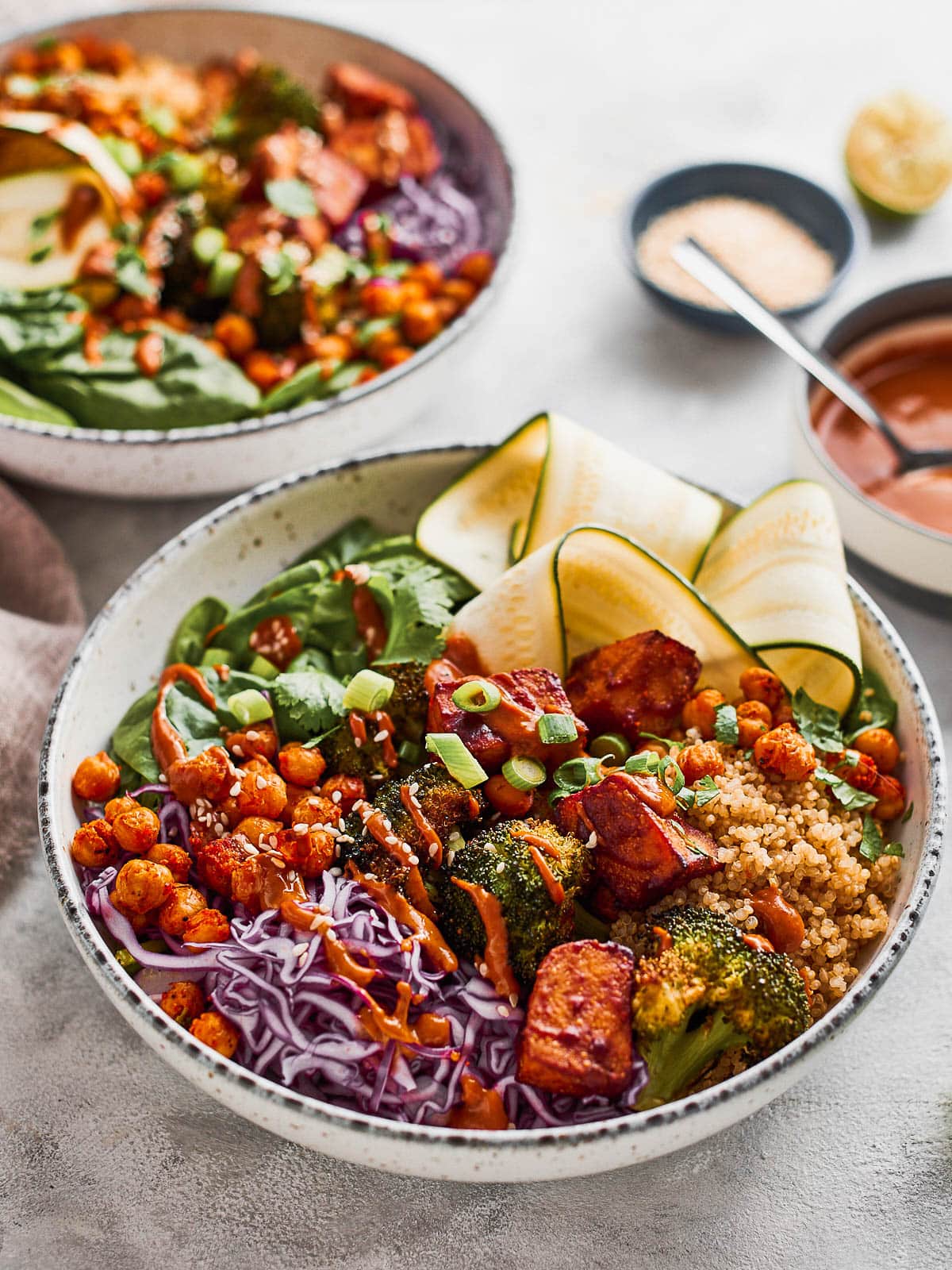
This post may contain affiliate links. As an Amazon Associate and member of other affiliate schemes I earn from qualifying purchases. For more information please view my privacy policy and disclosures.
Why I love tofu buddha bowls
I love making vegan buddha bowls for easy and healthy lunches. They’re great for meal prep as you can make all of the separate components and store them in the fridge until you’re ready to eat, and even mix and match different foods on each day.
Tofu buddha bowls are a great way to get loads of nutrition in with minimal fuss. They’re filled with protein, fibre and healthy fats, but also tonnes of flavour! You can make vegan protein bowls anything you want them to be, and they’re great for using up odds and ends in your fridge and freezer.
We eat loads of buddha bowls, but normally improvise and throw together whatever we fancy. Since posting my Mexican buddha bowls, they have become the most highly viewed recipe on the blog, so I thought I would treat you all with a delicious Thai buddha bowl recipe!
This Asian buddha bowl is a quick meal and super healthy, filled with colourful veg and a variety of fibre and protein sources. It’s gluten free too, so is perfect for a variety of dietary requirements. You could also make this recipe nut and soy free, and I’ve given some suggestions on how to do that towards the bottom of this post.
This peanut tofu buddha bowl recipe includes an easy, hands off way to cook tofu using no special equipment, so it’s perfect for those trying tofu for the first time.

Vegan protein sources
There are so many mixed messages about veganism and protein- I’m pretty sure we’ve all had the ‘but where do you get your protein?’ question!
The long and short of it is that we really don’t need as much protein as some people might make out. If you’d like some more information about veganism and protein, the Vegan Society has a really simple factsheet, and Forks Over Knives have a much more in-depth article too.
You can get protein on a vegan diet from foods such as tofu, tempeh, beans, lentils, peanut butter, other nuts and seeds, quinoa, and even vegetables. Protein can help you to build muscle mass, so if you are exercising and trying to lose weight and build muscle, you might like to include a little more of it in your diet.
This healthy buddha bowl with peanut sauce contains a variety of protein sources, with tofu, quinoa, chickpeas, and even broccoli, meaning that you can get all 9 of the essential amino acids from this meal.
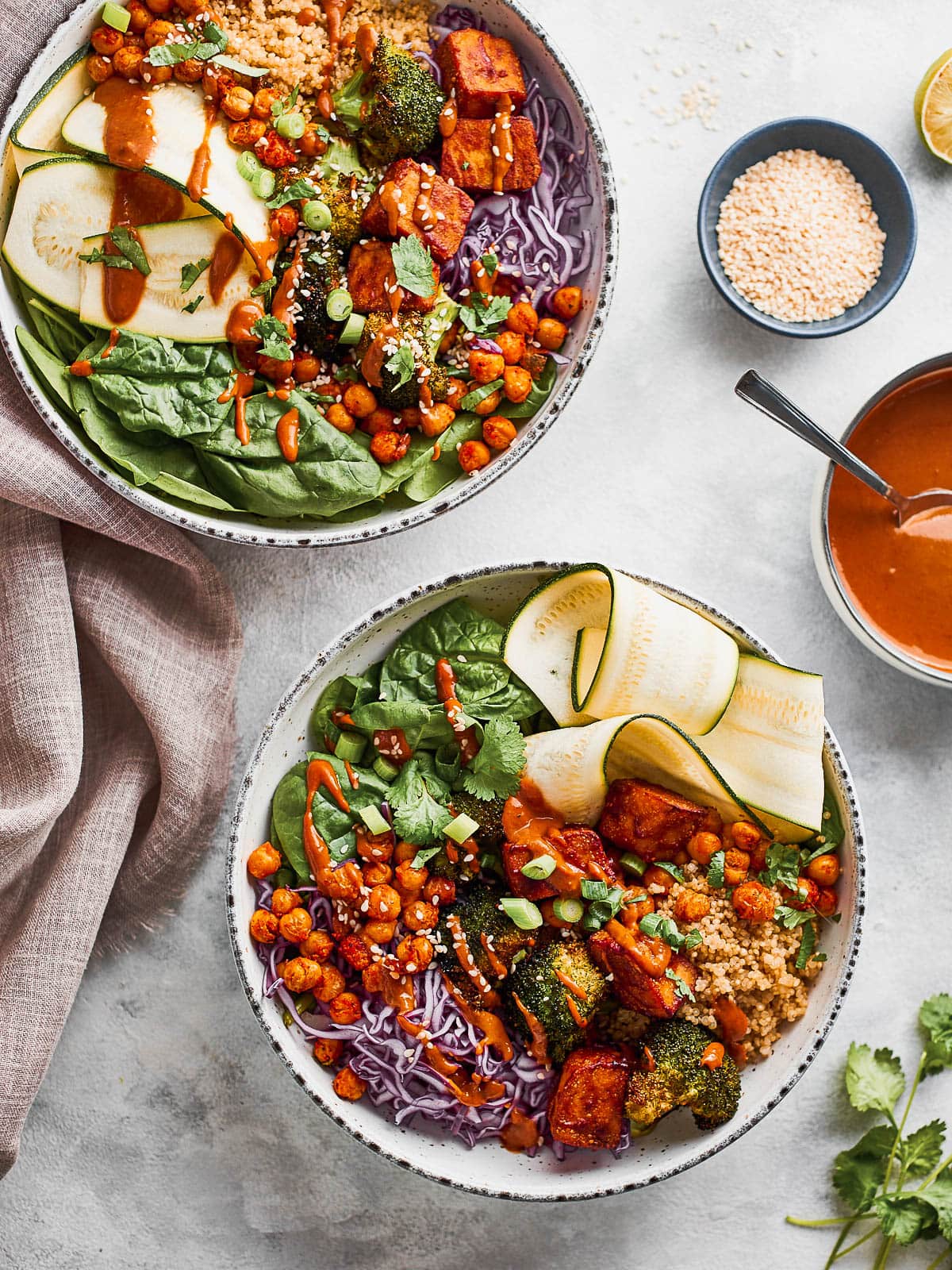
What are the components of a buddha bowl?
Base- All buddha bowls start with a base ingredient! This is normally a grain or a leafy vegetable. I’ve gone with both spinach and fluffy quinoa in this Asian buddha bowl! Spinach is a nutrient rich option when it comes to leaves, with a large amount of fibre, vitamins and minerals (it’s an excellent source of iron!).
Quinoa is actually a gluten-free seed, which makes a great alternative to brown rice and other grains. It is loosely defined as a whole grain, but contains all 9 of the essential amino acids, making it a great plant based protein source.
Protein- This vegan quinoa bowl gets extra protein from chilli garlic roasted chickpeas, and satay baked tofu. As mentioned above, tofu is a great protein source which can be used in so many different dishes, from coconut tofu and cannelloni to vegan shakshuka and tofu korma. This peanut tofu is seriously good, it’s so easy and super tasty, and is perfect piled on top of veggies and grains.
Veggies- I’ve chosen to add thinly sliced crunchy cabbage and zucchini to my peanut tofu buddha bowls. Along with the spinach, these bring plenty of vitamins and minerals to the bowl, as well as a good helping of fibre. Raw vegetables are great at filling you up, reducing the need to snack in the afternoon. Sesame broccoli is the only cooked vegetable in this tofu bowl, which is roasted alongside the tofu and chickpeas.
Sauce- The peanut sauce in this satay buddha bowl is made from peanut butter, soy sauce, sriracha, rice vinegar, lime juice, minced ginger, and water. Mixed together, they create a thick and creamy sauce which is the perfect coating for the crispy tofu and is delicious drizzled over the bowl.
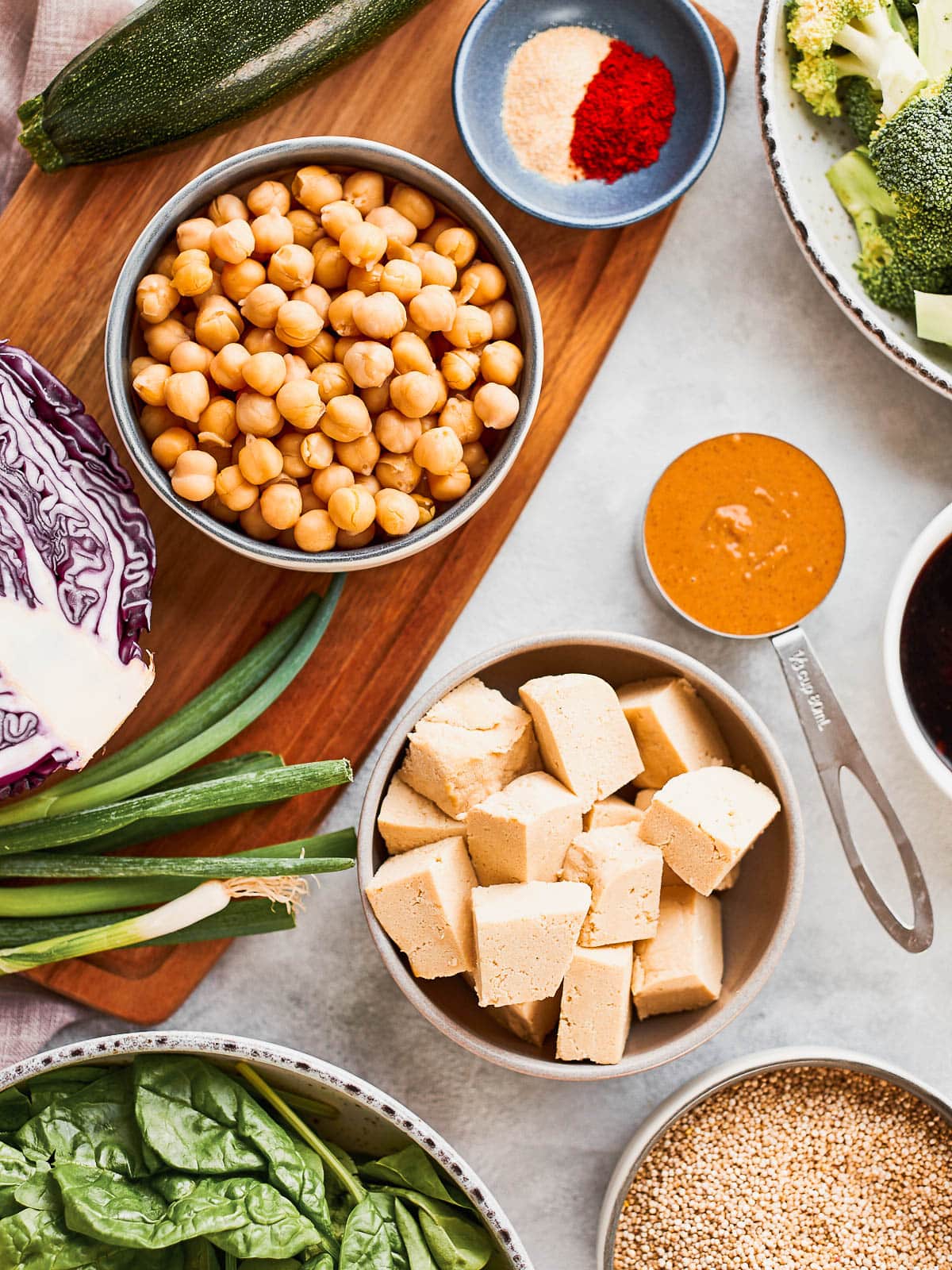
What kind of tofu should I use?
For these vegan tofu buddha bowls, it’s important that you use firm tofu. Extra firm tofu is my favourite here, as it doesn’t need pressing, saving time on the recipe. It holds its shape once it’s cut into cubes, and doesn’t fall apart when you toss it in the sauce. Once baked, it has a wonderfully meaty texture which is just so delicious.
If you buy firm tofu in water, you will need to press it before cooking with it. You can either use a tofu press for this, or do it the DIY way. To do this, slice the block of tofu in half along the length, resulting in two thin slabs. Wrap them in a clean towel, then place them on a plate.
Next, you need to put something heavy on the top- lots of things work here. You can use cookbooks, cans of beans, chopping boards, or cast iron cookware. The heavier it is, the quicker it will press. Leave the tofu like this for at least 30 minutes, then unwrap from the towel.
How to make tofu buddha bowls
The great thing about this recipe is that there is no special equipment required, only some baking sheets, a saucepan, and chopping equipment. You can use a mandolin to thinly slice the vegetables if you would like, but a sharp knife is perfectly good!
Start by preheating the oven to 200 celsius/390 fahrenheit. To make the satay sauce, mix together the peanut butter, soy sauce, sriracha, rice vinegar, lime juice and minced ginger. Stir until smooth, then gradually add in the water, stirring as you go. The sauce will loosen up a little, but should still be relatively thick.
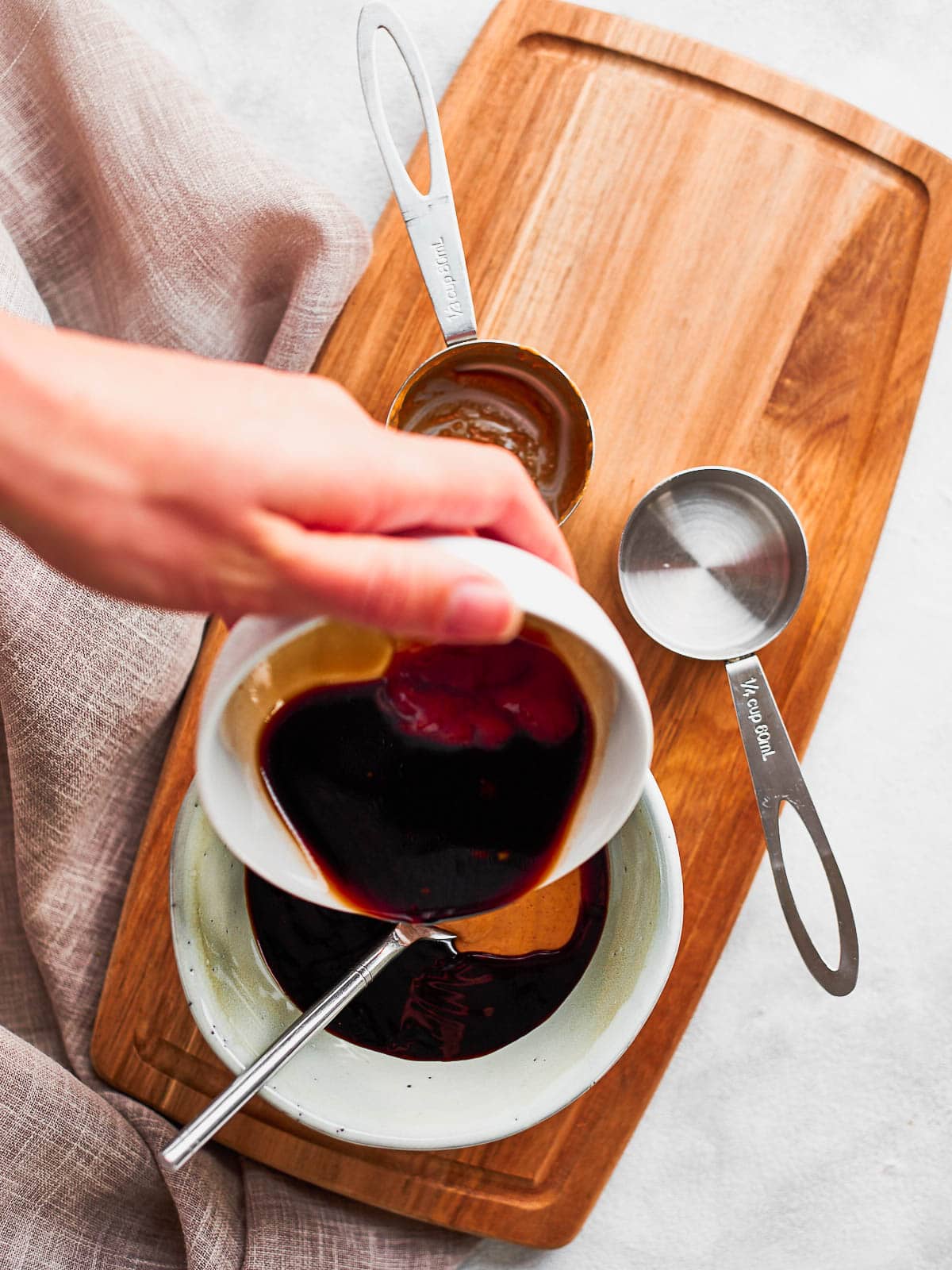
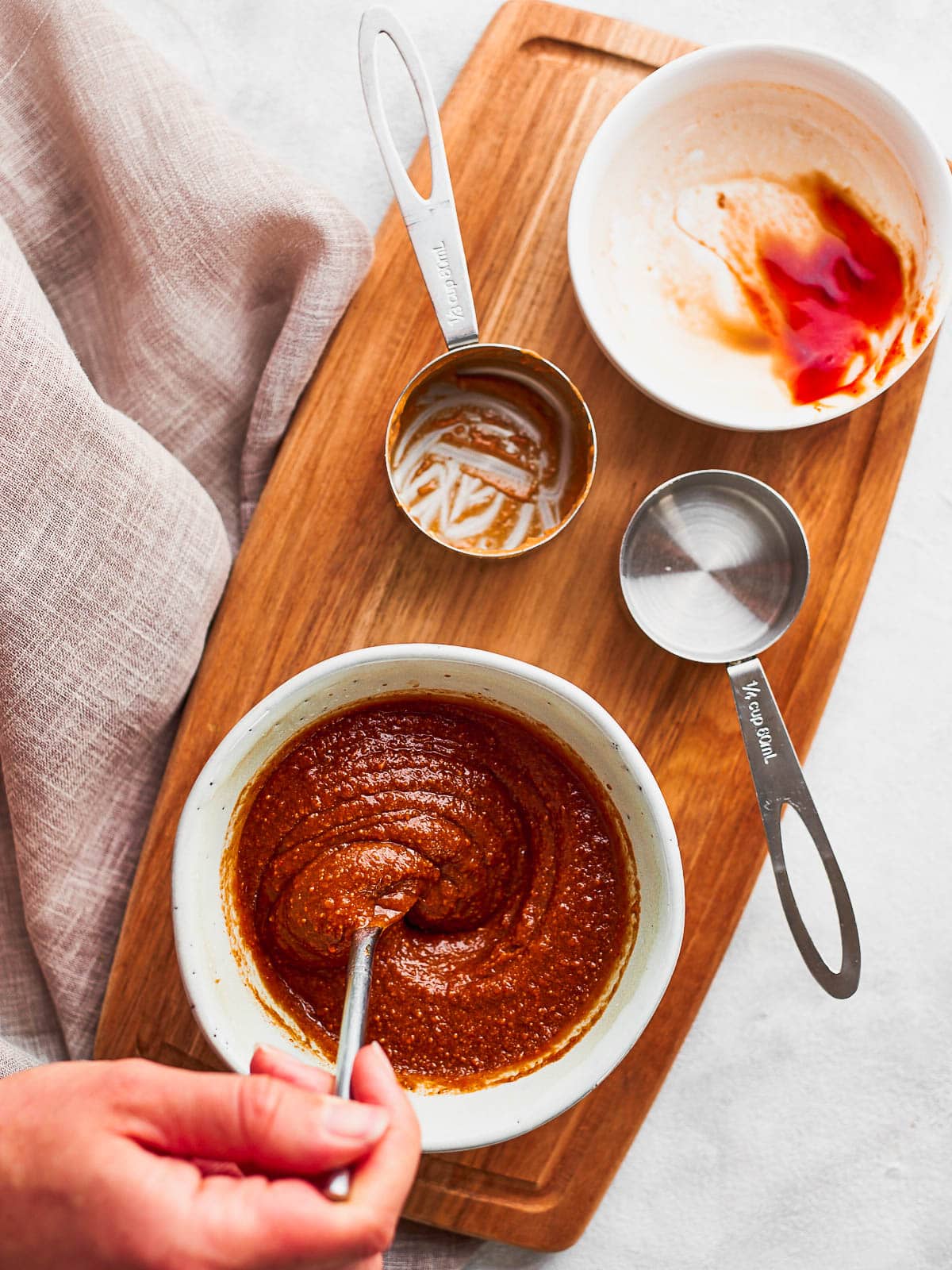

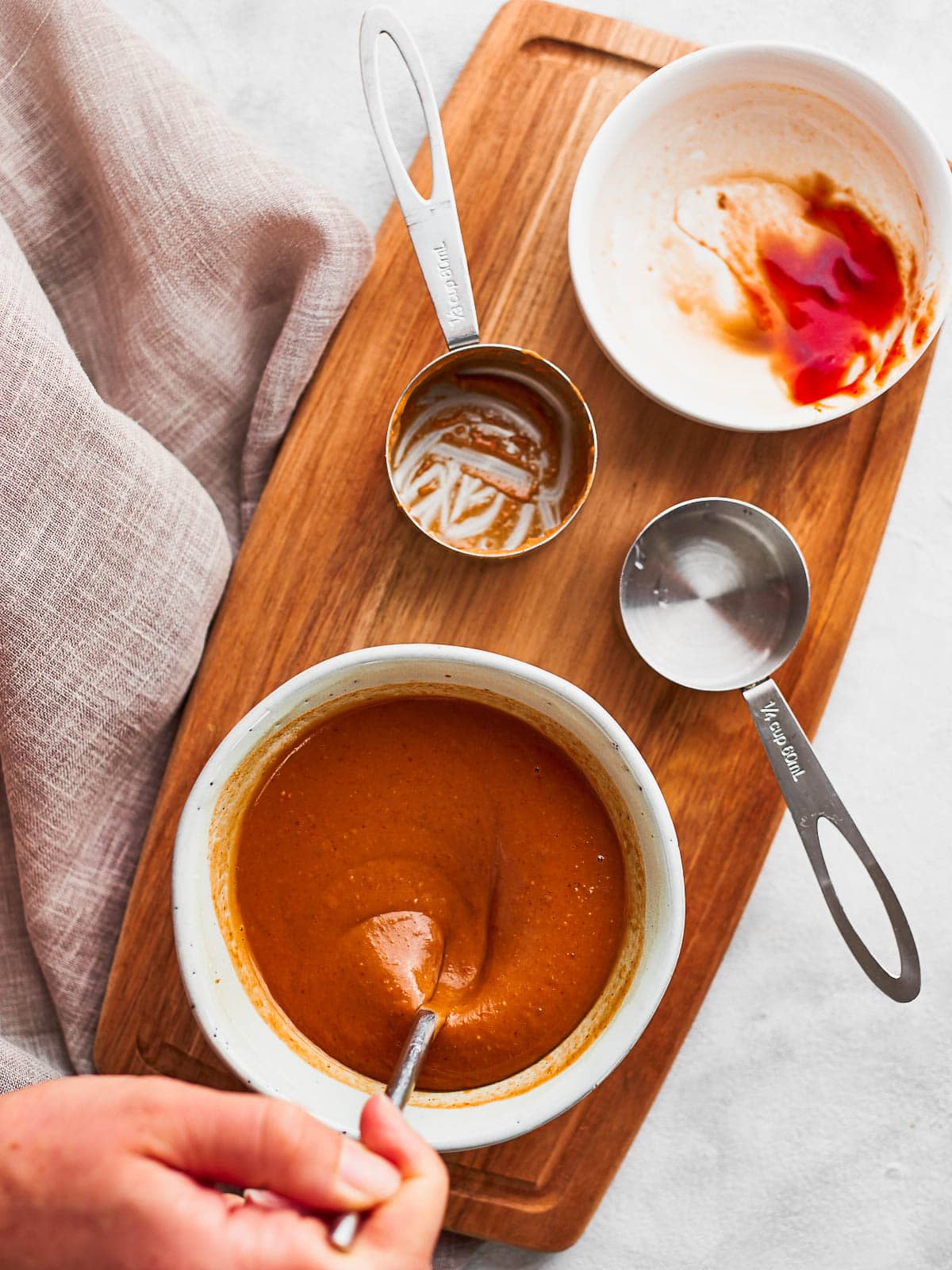
Cut the tofu into cubes approximately 1 inch in size. Put them in a bowl, then add a few spoonfuls of the satay sauce (just enough to coat). Reserve the rest of the satay sauce to use as a sauce later. Stir to coat the tofu, then lay it out on a lined baking sheet.
Stir the sesame oil through the broccoli and season with salt and pepper. Tip the chickpeas into a bowl and stir through the oil, chili powder, garlic granules, salt and pepper. Place the chickpeas and broccoli side by side on a large baking sheet, or on two small ones.





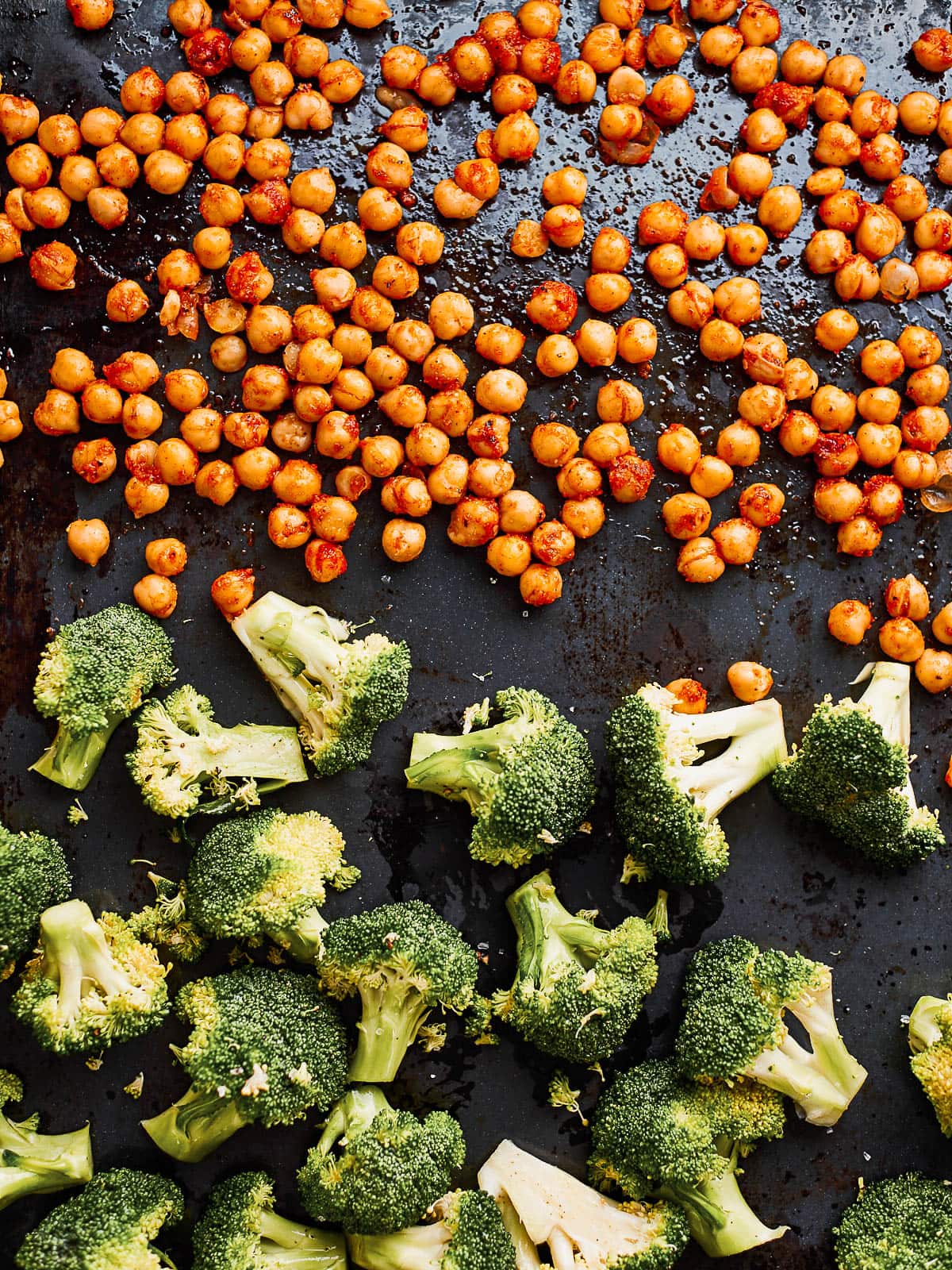
Put the tofu, broccoli and chickpeas in the oven and cook for 15 minutes, turning half way through.
Meanwhile, cook the quinoa. Add it to a saucepan with 375ml/1.5 cups of water and a little salt. Bring to a boil, then reduce to a simmer, and cook for 15 minutes, covered.

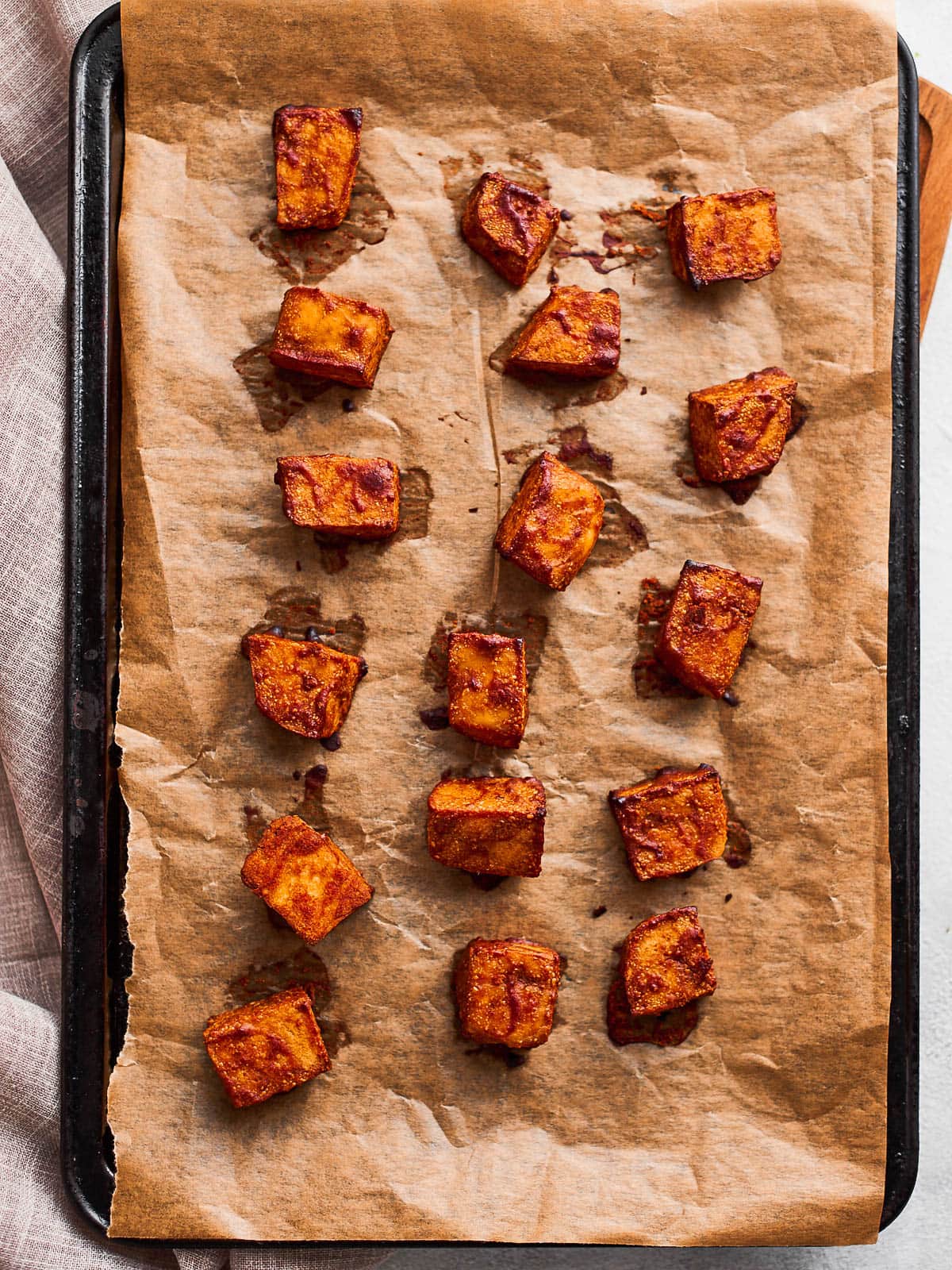


Thinly slice the zucchini and cabbage. Arrange them in a bowl with the spinach, cooked quinoa, satay tofu, broccoli and chickpeas, then drizzle over some of the satay dressing. Top with cilantro, green onion and sesame seeds.
How to serve vegan protein bowls
I love these tofu quinoa bowls because you really can top them with whatever you like. Instead of (or as well as!) cilantro, green onion and sesame seeds, you could use:
- Other toasted seeds such as pumpkin, hemp or sunflower seeds, for a bit of crunch.
- Nigella (black onion) seeds– I love the flavour of these.
- Any other herb, such as parsley or chives, or even microgreens.
- A big dollop of dairy free Greek yoghurt.
- Or your favourite dip, such as hummus.
If you’re extra hungry, you can even serve these Asian buddha bowls with flatbread or pita on the side.

My top tips for making tofu buddha bowls
- Make sure you use the right tofu! As mentioned above, you will need firm or extra firm tofu for this recipe.
- This recipe doesn’t require you to marinade the tofu, but you can if you want to. This will impart more of the marinade flavour onto the tofu, making it even tastier!
- This tofu quinoa bowl doesn’t take long to make, as long as you make everything in the right order. Get the tofu in the oven, followed by the chickpeas and broccoli, Whilst they’re baking, you can cook the quinoa and get the veggies chopped, and your food will be ready in less than half an hour.
- Minimise the washing up by using baking paper underneath the tofu, chickpeas and broccoli.
- If you would rather, you can fry the tofu. Coat the tofu as instructed, then fry it in a large pan over a medium heat with enough olive oil to stop it from sticking. Make sure you turn the tofu regularly so it doesn’t burn on one side.
- Sprinkle the raw veg with a little bit of lemon or lime juice. The citrus keeps it fresh for longer and stops it going brown and bitter.
- The tofu buddha bowl sauce is so versatile! Use it as a dip, in a stir fry, on baked potato, as a salad dressing, and even on roasted vegetables.
Ingredient substitutes or additions
I love vegan protein bowls because you can swap and change the ingredients so easily, depending on what you have in or what you’re in the mood for.
- I’ve used spinach and quinoa as the base of my vegan tofu buddha bowl here. To keep it a little lighter you can swap out the quinoa for more spinach (this also means less cooking!). If spinach isn’t your jam you could use kale, other baby leaves, or a crunchy green like romaine.
- You can swap out the quinoa for your favourite grain, such as brown rice, pasta, buckwheat, couscous, roasted sweet potato, or cauliflower rice for something a little lighter.
- Try swapping out the tofu for another protein, such as tempeh or edamame, or keep it soy free by using beans, seitan, or chickpeas.
- Switch up the veggies- roasted, steamed, baked, or raw; however you like them, veggies are a colourful addition to buddha bowls, with contrasting tastes, textures and nutritional profiles. Mix onion in with the roasted broccoli or swap the broccoli out for cauliflower; add some raw snap peas, cucumber and bell pepper; or keep it seasonal- add asparagus in spring, and roasted butternut squash or pumpkin in autumn.
- Double or half the recipe to suit your needs!
- Make the sauce nut free by using a seed butter such as sunflower seed butter.

FAQs
These crispy tofu buddha bowls are delicious eaten right away, but most of the time I make them for meal prep. A balanced meal that keeps you going all afternoon, they are still super tasty for up to 5 days.
The vegan quinoa bowls keep best if the components are stored separately in the fridge, then put together on the day or the night before. Bento style boxes are perfect for meal prep as they keep the components packed separately, but together at the same time.
If you would rather just pack everything together ready for the week, my only suggestion would be to store the peanut sauce in a little pot separately, then pour it over before eating. This will keep it nice and fresh and stop it from soaking into your food and making it soggy.
Vegan protein bowls are intended to be enjoyed cold, but you could warm up the cooked foods (quinoa, broccoli, chickpeas and tofu) if you would like to. The easiest way to do this would be to warm them in the microwave for a couple of minutes until hot through. If you want to do this, you would need to store them separately from the raw vegetables.
Looking for some more meal prep ideas?
You might like these recipes:
- This rice salad with pecans and apples (perfect for autumn)
- A bowl of homemade vegan pesto orzo salad
- This tofu katsu salad– with a delicious katsu sauce dressing!
- A miso coated edamame and cauliflower salad
- Baby corn salad with an Asian dressing
- Or this baked teriyaki tofu and cauliflower
Pin it!


Tofu Buddha Bowl [Vegan + High Protein]
Ingredients
For the sauce
- 90 g peanut butter ⅓ cup
- 3 tbsp dark soy sauce
- 1 tbsp sriracha hot sauce
- 1 tbsp rice vinegar
- ½ lime juiced
- 1 tsp minced ginger
- 4 tbsp water
For the buddha bowls
- 1 block extra firm tofu ~300g*
- 1 medium head broccoli cut into florets
- 1 tbsp sesame oil
- 1 400g can chickpeas drained and rinsed
- ½ tbsp olive oil
- ½ tsp chili powder
- 1 tsp garlic granules
- 200 g quinoa 1 cup
- 1 small zucchini ~250g
- ¼ red cabbage ~200g
- 1 handful fresh baby spinach
- Cilantro, green onion and sesame seeds (to serve)
Instructions
- Preheat the oven to 200°c/390°f.
To make the satay sauce
- Mix together the peanut butter, soy sauce, sriracha, rice vinegar, lime juice and minced ginger. Stir until smooth, then gradually add in the water, stirring as you go. The sauce will loosen up a little, but should still be relatively thick.
To make the buddha bowls
- Cut the tofu into large cubes (approx 1 inch). Put them in a bowl, then add a few spoonfuls of the satay sauce to coat. Reserve the rest of the satay sauce to use as a dressing later. Stir to coat the tofu, then lay it out on a lined baking sheet.
- Stir the sesame oil through the broccoli and season with salt and pepper. Tip the chickpeas into a bowl and stir through the oil, chili powder, garlic granules, and salt and pepper to taste. Place the chickpeas and broccoli side by side on a large baking sheet, or on two small ones.
- Put the tofu, broccoli and chickpeas in the preheated oven and cook for 15 minutes, turning half way through.
- Meanwhile, cook the quinoa. Add it to a saucepan with 375ml/1.5 cups of water and a little salt. Bring to a boil, then reduce to a simmer, and cook for 15 minutes, covered.
- Thinly slice the zucchini and cabbage. Arrange them in a bowl with the spinach, cooked quinoa, satay tofu, broccoli and chickpeas, then drizzle over some of the satay dressing. Top with cilantro, green onion and sesame seeds.
Notes
Nutrition
Made this recipe?
I’d love to know how you got on- let me know how it turned out in the comments below!
Or if you’d rather you can Pin it, or share it on Facebook (forkfulofplants) or Instagram (forkful_of_plants). Don’t forget to tag me!
Want to hear more from me?
Sign up to my newsletter below and I’ll make sure you’re the first to know when I post a new recipe!

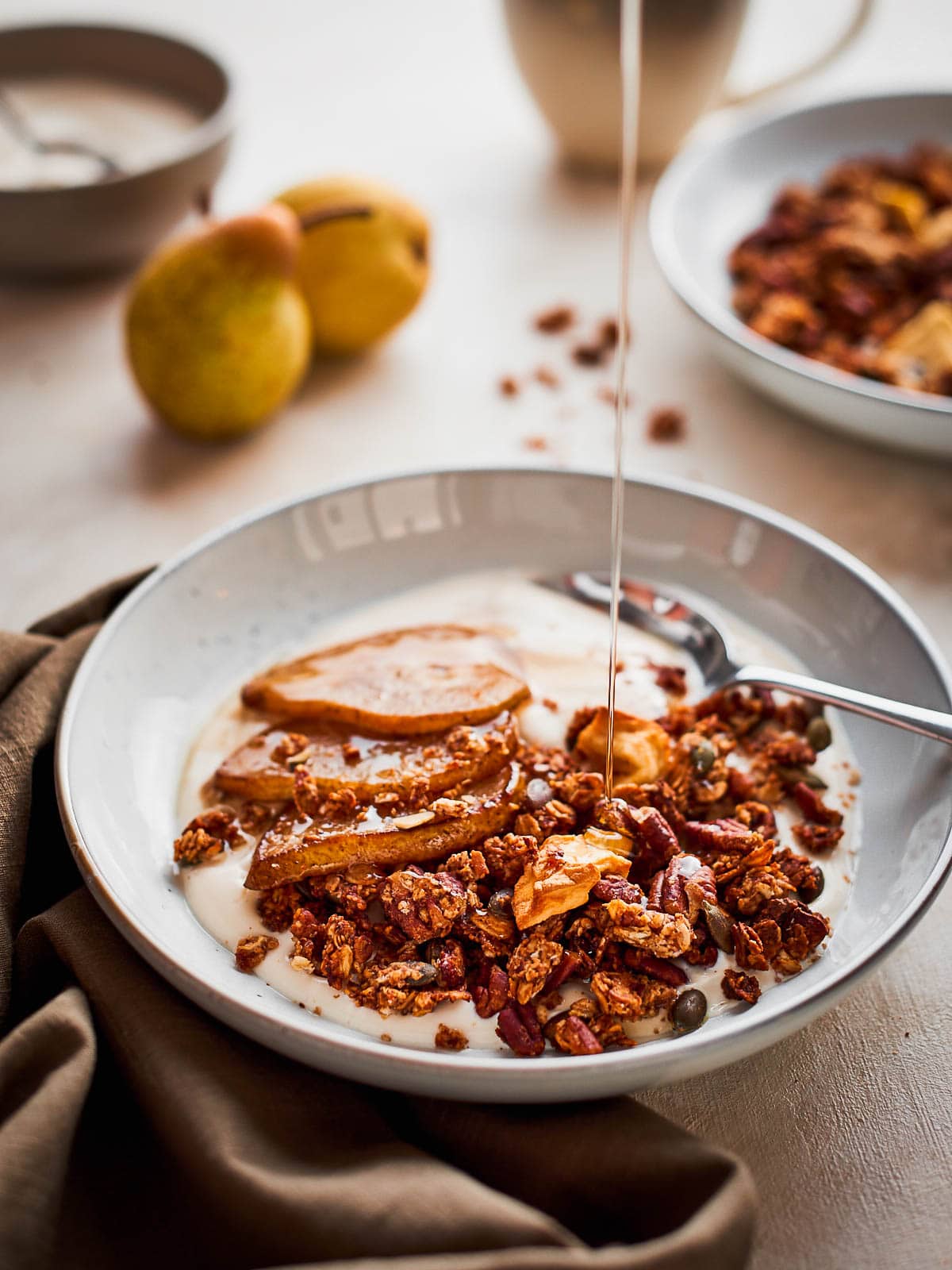



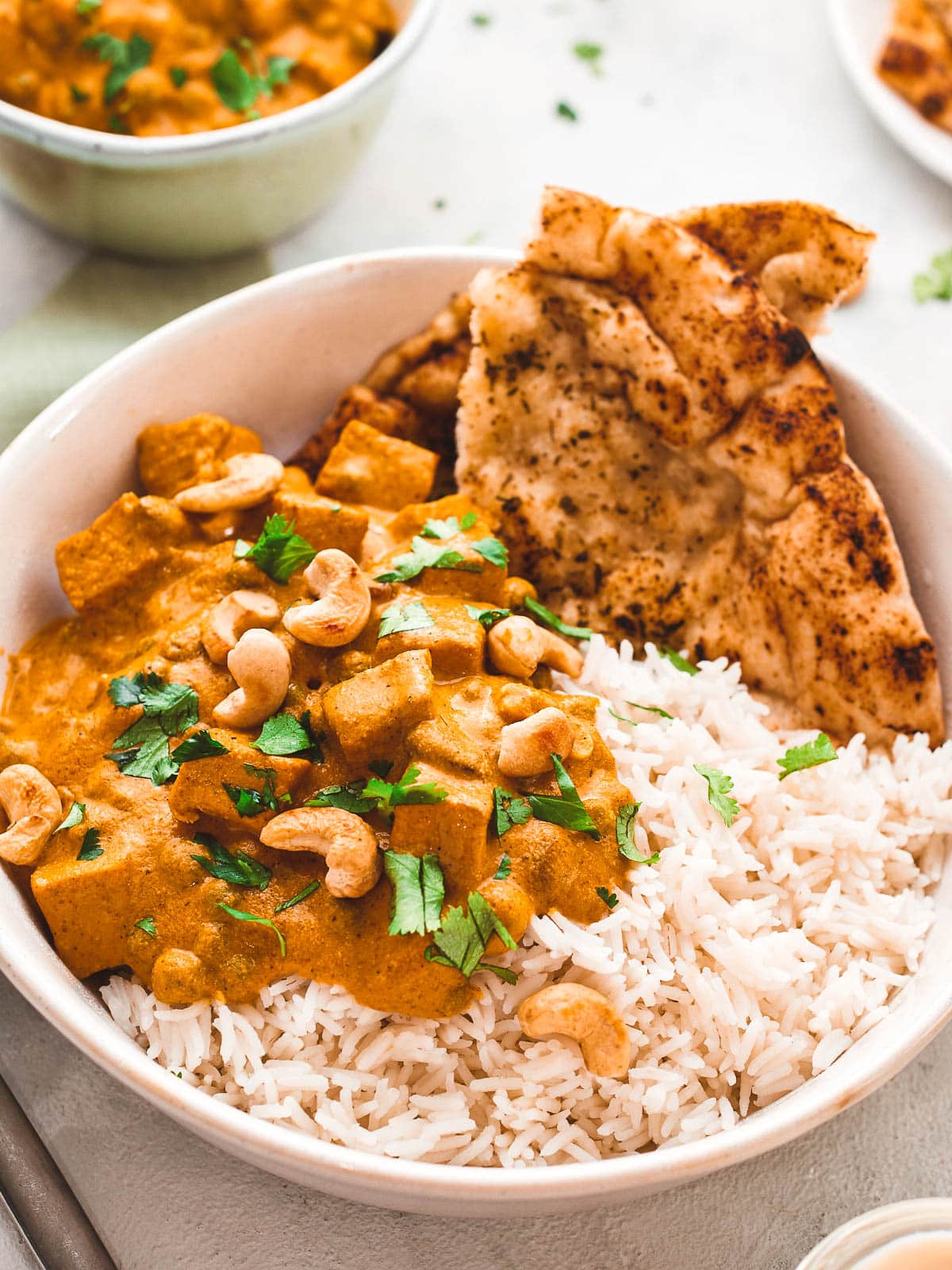
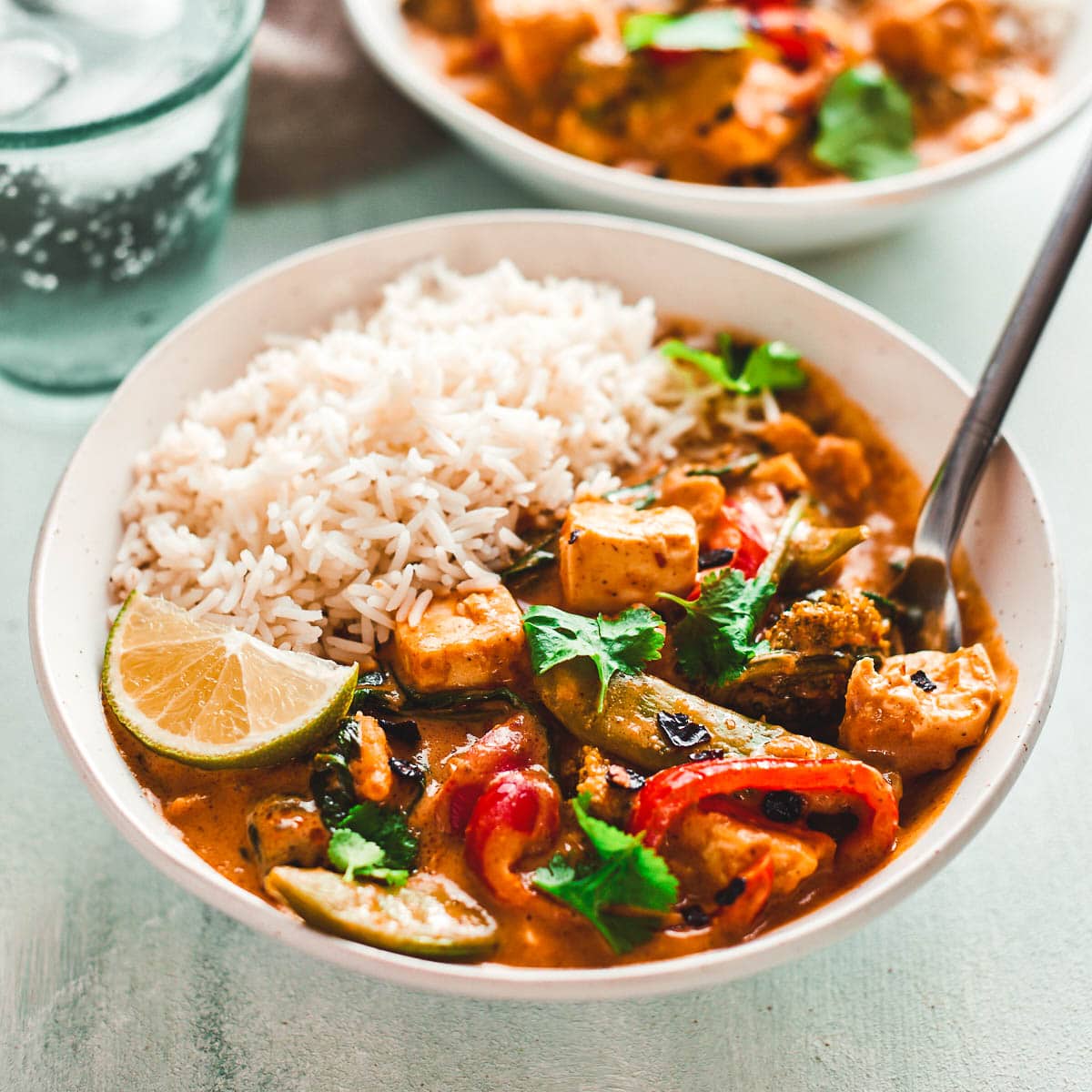
This looks absolutely delicious – thanks for this post. One question I couldn’t find in the FAQs / info is how many calories per recipe/ serving? Is this information available? Thanks.
You’re more than welcome! This works out around 550 calories per portion, but this may very slightly depending on exactly which ingredients you use (e.g brand of peanut butter or tofu). Hope this helps 🙂
Loved it! Perfect dinner for when you don’t have much time but want something tasty and fresh. I ended up cooking the zucchini with the broccoli as opposed to having it fresh. The satay sauce was soo easy and delicious. Great recipe 🙂
Hey Lexi, thanks for the comment. Great to hear that you enjoyed this recipe!
This is….. AMAZING FREAKING DELICIOUS!!! Will definitely be making this more often! So grateful for you!
Thank you Lexi, so glad you enjoyed this one!
This is my favourite thing to make after a gym session! So tasty, low effort and full of protein! Thanks for the recipe 🙂
Great to hear that you love this recipe Merce! Thank you for the lovely review 🙂
I’ve made a lot of Buddha Bowls. This is a great recipe, sauce is perfect! I switched out with veggies I had. This was yummy!
Thank you Rob!
Looking forward to making this! FYI – I noticed spinach is missing from the ingredients list. I skipped to the recipe and almost missed it in my shopping list. Hopefully a quick/easy fix on your website. 🙂
Hey Kirstin, thank you so much for pointing this out! I’ve updated the recipe. Hope you enjoyed your buddha bowl 🙂
Thanks for the great recipe! Satay sauce was so easy to make and tasted amazing
Thank you for the lovely comment 🙂